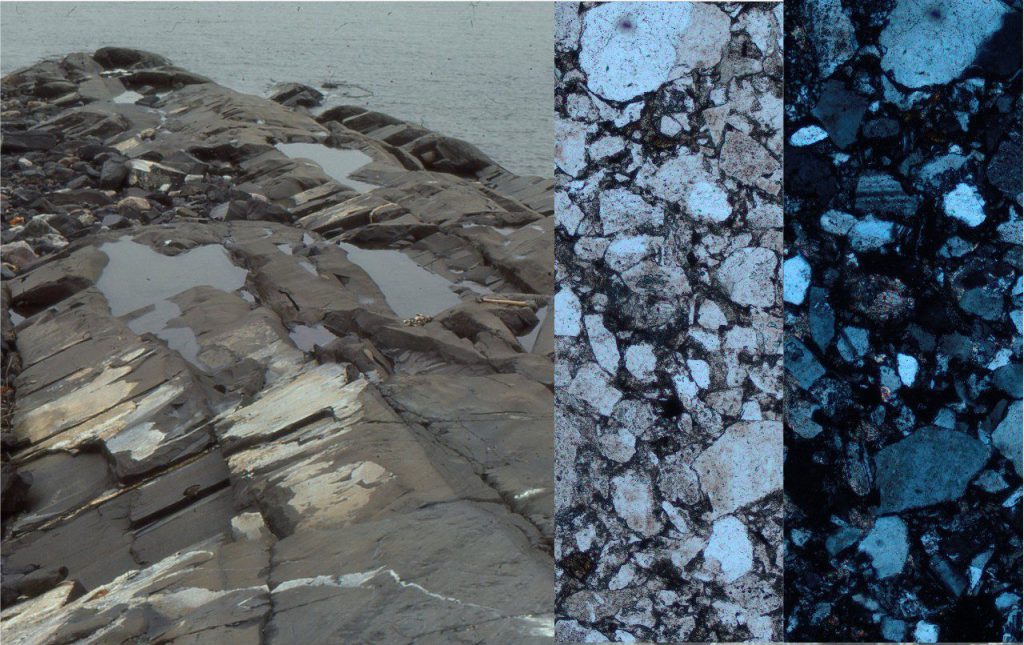Greywacke petrography
On the outside, greywacke is generally presented in varying shades of grey commonly with greenish hues, hammer-ringing hard, even splintery indurated rock. Most originate as deep- water successions of turbidites and debris flows, in seemingly endless stratigraphic piles 100s to 1000s of metres thick. Typically, they lack body fossils but may contain diverse trace fossils on bedding.
Greywackes in thin section can be difficult to work with. By definition they contain at least 15% matrix, but the distinction between framework grains and matrix can be difficult. In part this is because there is an almost continuous grain-size gradation from the coarsest to finest particles; what constitutes matrix becomes a moot point. The other problem with wacke matrix is that it tends to be chemically reactive and given the depths of burial, may be completely masked by diagenetic products such as clays, sericite, and chlorite. Labile constituents like feldspar, mica and ferromagnesian minerals will be prone to alteration and even complete replacement by calcite, chlorite, and low metamorphic grade minerals like prehnite.
Sericite: is a flaky, white mica and common alteration product of feldspar. In thin section it usually presents as fine ragged crystals (rather than the more uniform muscovite flakes), concentrated along feldspar cleavage planes, or distributed across the entire crystal. It has high birefringence and appears to sparkle against the dull background of altered grains and matrix.
Chlorite: is easily distinguished from sericite by its low birefringence, varying shades of green (in PPL), and crystal habit that is also variable, from fibrous, spherulitic or vermiform (worm-like). May be pleochroic in shades of green and yellow. It is commonly associated with low grade metamorphism and hydrothermal alteration.
Refer to this link for a reminder of optical mineralogy terminology
Greywacke
Two samples from the Omarolluk Fm. Paleoproterozoic, Belcher Islands, Hudson Bay. The notes apply to both sets of images, plain polarized light (PPL) on the left, crossed nicols on the right.
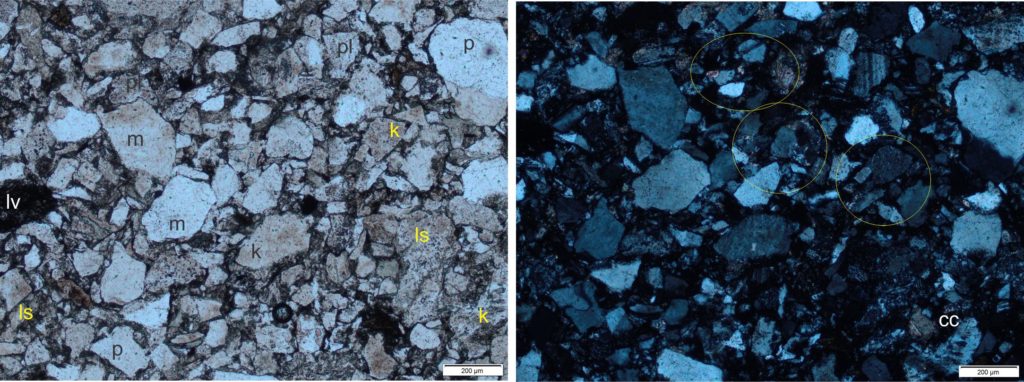

Thin section of greywacke, Omarolluk Fm. Paleoproterozoic, Belcher Islands, Hudson Bay. PPL and crossed nicols.
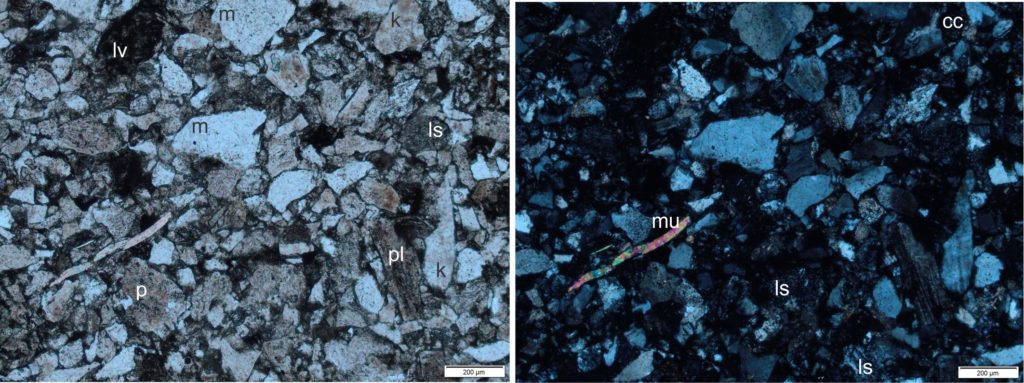

Thin section of greywacke, Omarolluk Fm. (#2) Paleoproterozoic, Belcher Islands, Hudson Bay. PPL and crossed nicols.
- Grain size ranges from 400μm (0.4 mm) to clay, with a mean hovering between 50-100μm.
- Framework grains are angular to surrounded.
- Poorly sorted.
- Framework is a mix of clast-supported and matrix-supported.
- The rock is texturally and mineralogically immature.
- Monocrystalline (m) and polycrystalline quartz (p) are generally clear in PPL (about 30-40% in total). Some of the silt and fine sand sized quartz may be derived by breakdown of larger polycrystalline grains.
- Monocrystalline quartz grains have variable degrees of strain, ranging from straight to sweeping extinction. This suggests that most of the crystal deformation was inherited from the source rocks, rather than being postdepositional.
- Plagioclase (pl – albite and carlsbad twinning) and potassium feldspar (k) (total about 30%) tend to be cloudy in PPL because of alteration to sericite (examples in circled area), chlorite, and clays. Chlorite gives grains and matrix a greenish hue. There are a few small patches of calcite replacement of feldspar (cc)
- Lithics (15% in Omarolluk 1; 20-25% in Omarolluk 2) consist of mud-siltstone and cherty mudstone (ls) and volcanic (lv), the latter showing relict feldspar lath textures.
- Depositional matrix and diagenetic cement about 15%.
- Muscovite flakes (mu <0.5%) are mostly altered to chlorite and bent around stronger grains (arrows). The few small pyroxene grains are highly altered.
- Paragenesis: Deposition → compaction (continuous) → feldspar alteration to sericite → clay precipitation → chlorite precipitation.
Greywacke
Greenland Group, Ordovician, NZ. Bar scale 350μm (0.35 mm).
Image credit: JJ Reed P35079, GNS Science. (2004). Petlab.
This sample gives us a nice illustration of a greywacke that has been subjected to low grade metamorphism, manifested as changes to grain framework and incipient structural fabrics.
- Quartz grains, about 40%, are angular and range from medium sand size to silt.
- Matrix appears at first glance to be very high – 40-50% but zoom in on the images to see the outlines of lithic grains (a few examples shown by yellow arrows). Many of the grains have amalgamated into diffuse masses, in part combining with the original matrix that probably was of similar composition to the lithics. For many lithic grains, the original size and shape will have changed because of advanced compaction, metamorphic reactions, and the development of an incipient structural fabric – cleavage. In this case, the distinction between matrix and post-depositional textures is fraught.
- Opaque minerals < 1%.
- The linear fabric, accentuated by the dark, evenly spaced, subparallel bands is incipient cleavage, a penetrative fabric that results from grain dissolution and precipitation through the entire sample (red arrows). Zoom in to see how the cleavage is diverted around quartz grains. Accompanying the cleavage is a subtle alignment of very fine mineral precipitates – probably a mix of chlorite and illite.
- Paragenesis: Deposition → compaction (continuous) → clay precipitation → formation of cleavage → clay + chlorite precipitation.
Greywacke (feldspathic wacke) – Crossed nicols only.
Rakaia terrane, Late Triassic to Permian (part of the Torlesse composite terrane).
Image credit:, P29217, GNS Science. (2004). Petlab.
- Coarse-grained, clast sizes ranging from 800μm (0.8 mm) to silt sized.
- Angular, poorly sorted, mostly clast-supported.
- Quartz 15-20%, a mix of polycrystalline (p) and monocrystalline grains (m).
- Feldspar 40-50% is mostly untwinned potassium feldspar (k – good cleavage) – there are a few small albite twinned plagioclase grains (pl). Some alteration to sericite (s).
- Lithics 15-20% (l).
- Matrix 15%.
- A small fracture traverses the upper half of the image (f1). The fracture is filled with quartz (?) where it cuts across a large feldspar grain.
- A second structural discordance along the left margin is more diffuse (f2); here there appears to be grain breakage and possibly some fracture-filling mineral precipitation that parallels the trend of the structure. It also appears to truncate the quartz-filled fracture.
- Paragenesis: Deposition → compaction (continuous) → feldspar alteration → cement precipitation → deformation fracture 1 → deformation fracture 2.
Greywacke
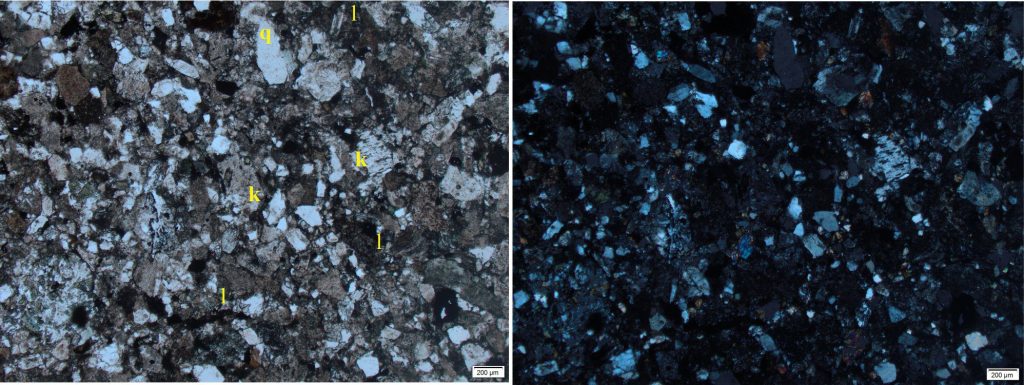

A typically ‘dirty looking’ greywacke where the distinction between framework and matrix is obscured by clay diagenesis and feldspar alteration. There is a high lithic content (l), plus a poorly sorted array of angular quartz grains (q) and K-feldspars (k), including untwinned and perthite twinned varieties. Some of the feldspars have been altered significantly and look superficially like lithic grains. Overall, the sample is texturally and mineralogically immature. Left: Plain polarized light; Right: Crossed polars.
Volcanic lithic greywacke
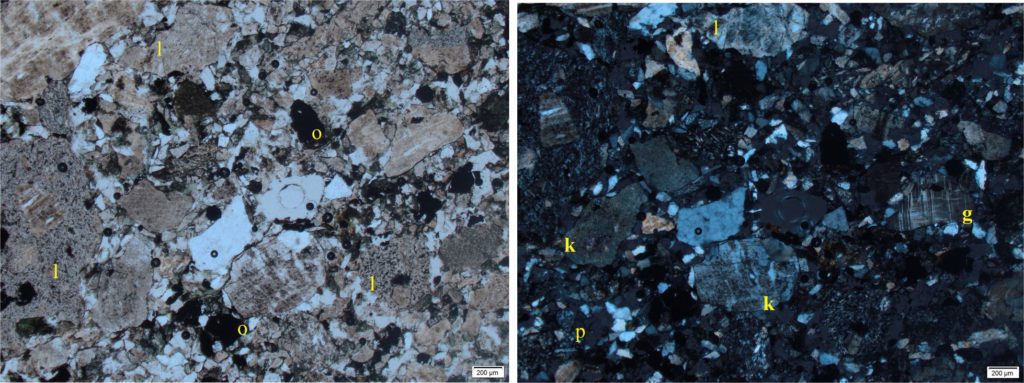

A coarse-grained greywacke with large lithic grains that have felted micro-feldspar textures and the occasional plagioclase phenocryst. K-feldspar is also abundant in untwinned (k) and gridiron twinned crystals (g), all showing significant alteration (probably to clays), giving them a dirty brown appearance in PPL. Quartz grains are subordinate, angular, and include a few polycrystalline types (p). There are a few coarse grained opaques (o). The rock overall is typically very poorly sorted and mineralogically immature. Left: Plain polarized light; Right: Crossed polars.
Other posts relevant to this article
The mineralogy of sandstones: porosity and permeability
The mineralogy of sandstones: Quartz grains
The mineralogy of sandstones: Feldspar grains
The mineralogy of sandstones: lithic fragments
The mineralogy of sandstones: matrix and cement
The provenance of detrital zircon
Provenance and plate tectonics
Ignimbrites in outcrop and thin section
Lithic grains in thin section – avoiding ambiguity

